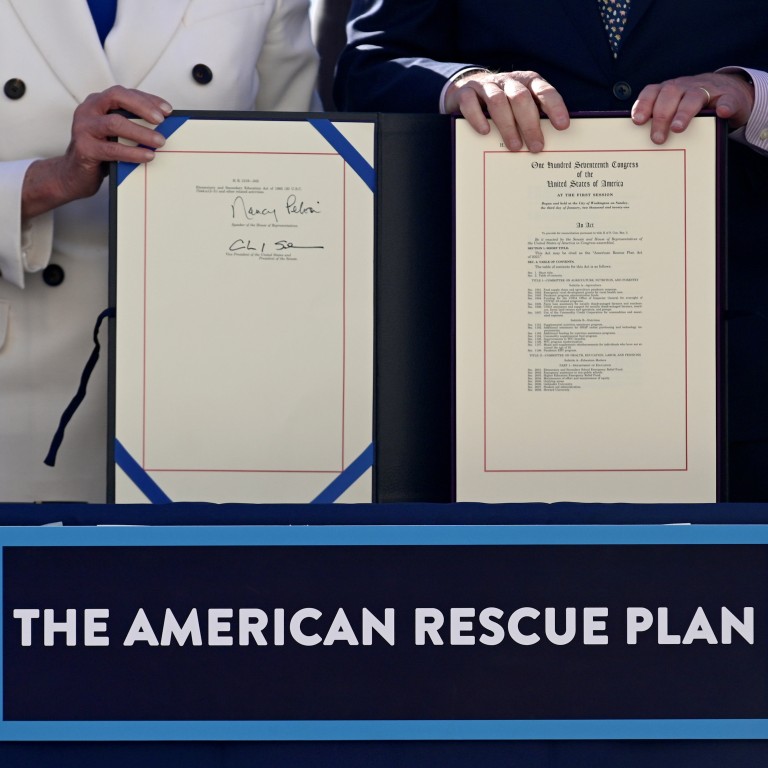
American Rescue Plan: US stimulus seen widening trade deficit that sparked Trump’s trade war with China
- Higher US interest rates and widening trade imbalance with China said to be side effects of President Joe Biden’s US$1.9 trillion American Rescue Plan
- With bilateral relations already at their lowest point in decades, a rising trade deficit could add fuel to the fire
The US$1.9 trillion American Rescue Plan is poised to attract more Chinese imports, and analysts expect it to widen the United States’ contentious trade deficit with the world’s second-biggest economy.
The stimulus will add about US$30 billion to US imports from China this year, estimates Derek Scissors, chief economist at China Beige Book International, a data-collection platform tracking the Chinese marketplace. And if all of the stimulus dollars were to be spent rather than saved, Societe Generale estimates it would pull in as much as US$40 billion in additional Chinese imports.
Even if China ramps up buying under a trade deal signed with the US in January 2020, this would not be enough to offset the gravitational pull of the stimulus. The risk is that, with bilateral relations already at their lowest point in decades, a rapidly widening trade deficit adds more friction – especially if China falls short of buying targets agreed in the trade accord.
“A strong recovery – for example, a 9 per cent increase in nominal [gross domestic product] – would push the bilateral goods deficit past US$500 billion and draw political attention,” Scissors said.
China’s trade with US failed to meet phase-one deal targets in 2020
An export orders subindex of the Caixin manufacturing purchasing managers index jumped to 51.4 in March from 47.6 a month earlier, signalling robust global demand.
Rabobank estimates China’s world-trade surplus will grow by almost 8 per cent in 2021 to US$576 billion, while HSBC Holdings sees it hitting a record US$630 billion, bigger than Thailand’s economy.
“US policy is lifting interest rates, the exchange rate and the trade deficit,” said David Dollar, a senior fellow at the Brookings Institution in Washington who previously served as the World Bank’s country director for China. “We need to recognise that this is the side effect of the large stimulus.”
Exactly where the bilateral trade balance lands this year also hinges on factors including the price of oil, which accounts for about 10 per cent of China’s imports, and on how aggressive China’s trade-deal buying is, says Michelle Lam, a China economist at Societe Generale in Hong Kong.
Last year, China fell about 40 per cent short of its commitment to buy an additional US$200 billion worth of US goods over two years, with the impact of the pandemic only partly to blame for the shortfall, according to an estimate by the Peterson Institute for International Economics in Washington. And in the first two months of this year, China fell farther behind the needed buying pace, the institute said.
The [trade] deal might be amended during the year, or possibly even abandoned altogether if tensions really flare up
New US Trade Representative Katherine Tai said at her confirmation hearings that she would enforce the trade deal. “Every good negotiator retains his or her leverage,” she told The Wall Street Journal last month, while adding that the US may be open to trade negotiations with China.
The deal calls for the US trade representative to meet with a Chinese vice-premier every six months. The next meeting is almost two months overdue, and there is no sign of talks being scheduled. “The deal might be amended during the year, or possibly even abandoned altogether if tensions really flare up,” says Michael Every, head of financial markets research for Asia-Pacific at Rabobank in Hong Kong.
Peterson senior fellow Chad Bown says the “dubious” policy of reducing the bilateral trade deficit should be scrapped anyway, because purchasing commitments have sowed distrust among allies that the US now wants to work with to tackle their China concerns. As a result, even a sharply widening US trade deficit with China may produce only a muted reaction from a Biden administration that is working on a broader China strategy than Trump did.

